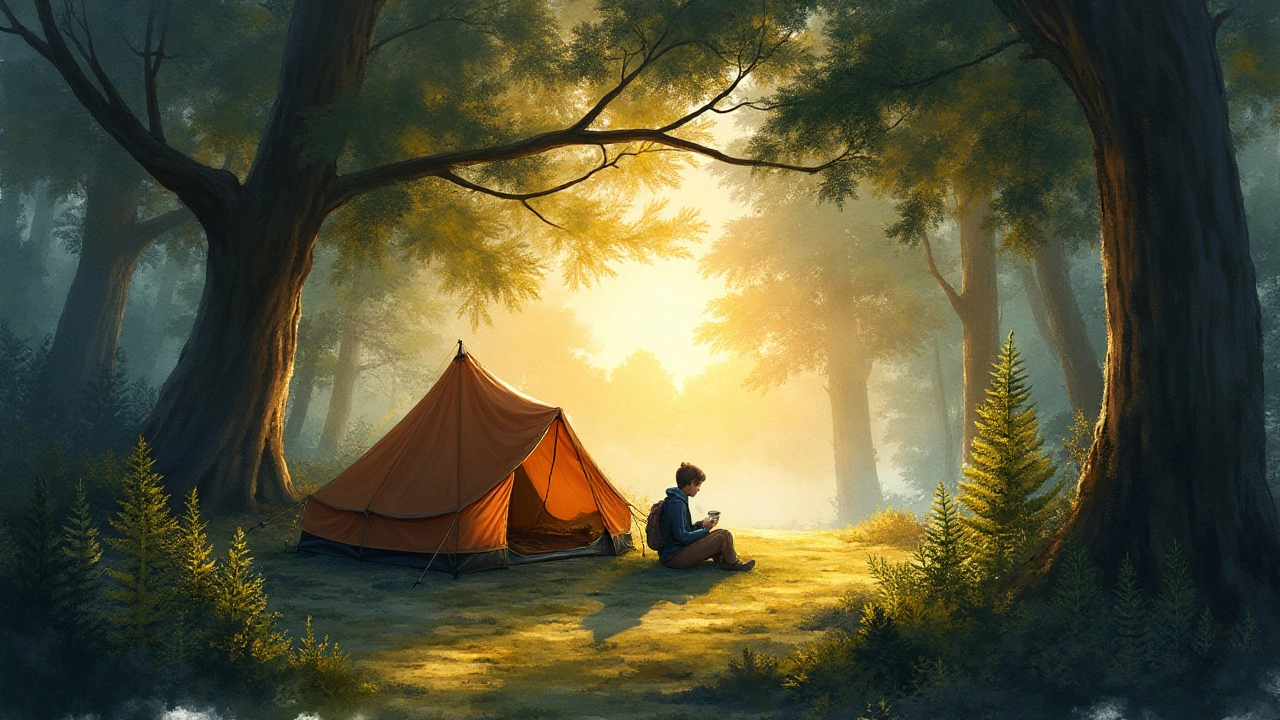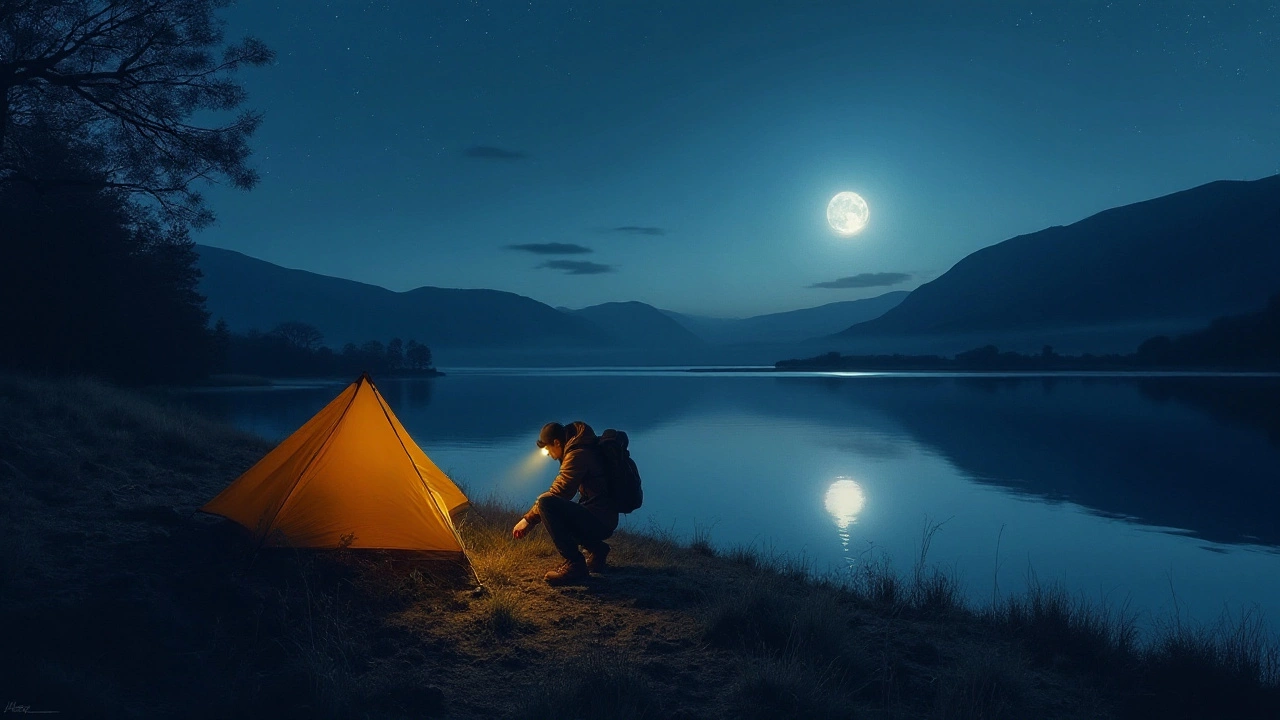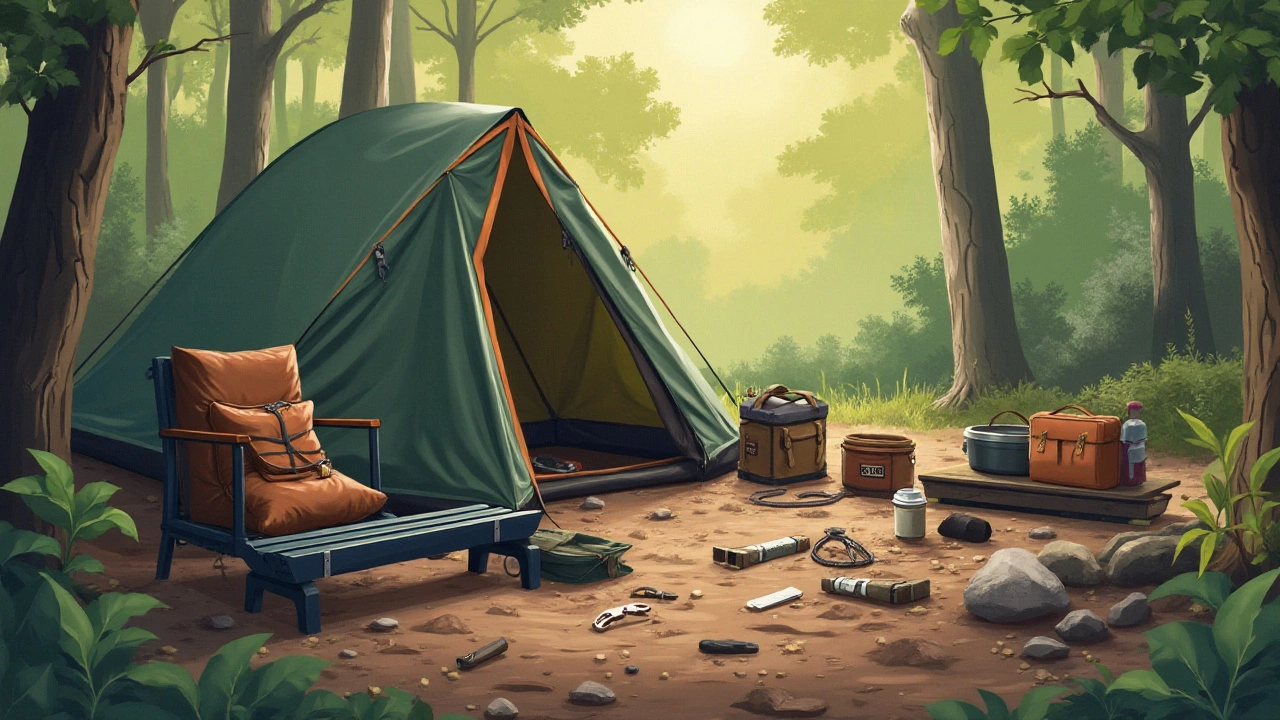Exploring the Eco-Friendly Art of Stealth Camping
 Feb, 3 2025
Feb, 3 2025
Stealth camping is more than just a camping style—it's a philosophy that embraces both adventure and responsibility. This unique form of camping focuses on setting up a temporary camp that goes unnoticed, usually in spots not designated for camping. Its allure lies in the promise of seclusion, a touch of mystery, and the deep connection it fosters with the great outdoors.
For those passionate about eco-friendly living, stealth camping offers a sustainable alternative to traditional campsites. By minimizing your footprint and ensuring that you leave nature as you found it, you can enjoy the serenity of the natural world while adhering to the principles of low-impact living. This type of camping is perfect for the adventurous at heart, especially those who cherish the freedom to explore off-the-beaten-path locations.
- The Concept of Stealth Camping
- Environmental Benefits
- Choosing the Right Spot
- Essential Gear for Stealth Camping
- Leave No Trace: Camping Etiquette
The Concept of Stealth Camping
Stealth camping is an adventure born out of the need for simplicity, freedom, and a deeper connection to the land surrounding us. Unlike traditional camping which involves venturing into conventional campsites, with their designated spaces and scheduled amenities, stealth camping invites outdoor enthusiasts to blend seamlessly into their surroundings. The allure of stealth camping lies in its roots of autonomy, as campers choose secluded, often unexpected, locations to pitch their shelters overnight.
The heart of stealth camping is discretion. It's about ensuring your presence is as natural and unobtrusive as possible. Outdoor spaces like forests, beaches, or even parks after hours, become temporary sanctuaries under the stars. While it might seem akin to the idea of wild camping, the subtlety of stealth camping is about melting into the environment. Ideally, you arrive late in the evening and leave at dawn, drawing as little attention as possible. This practice is particularly popular among long-distance hikers and bikepackers who seek shelter in spots outside of regular trails when campsites are full, or they wish to maintain a more flexible schedule.
While stealth camping isn't typically reinforced by the usual infrastructures of formal campgrounds, it holds a certain charm. Arguably, some might say it's almost poetic—immersing yourself in an untouched environment just as it is—with all its nocturnal symphonies and whispering foliage. Often, it calls for a heightened awareness of your surroundings, challenging you to respect the land's natural order while satisfying a primal yearning for exploration.
"To see the world, things dangerous to come to, to see behind walls, draw closer, to find each other and to feel. That is the purpose of life." - Walter Mitty, a tribute to the unseen adventures like stealth camping that expand our horizons and nurture our spirits.
In practicing stealth camping, one must also adhere to the ethics integral to sustainable travel. This means not only leaving no trace by gathering all trash and ensuring the site is cleaner than when you arrived but also being mindful of the impact your presence might have on wildlife and vegetation. Awareness and cautiousness go hand in hand as you blend into these ecosystems without disturbing them.
As this particular style of camping gains popularity, it's crucial to understand its nuances and legal stipplings. While many regions embrace the idea of adventure and self-sufficiency, land ownership and local regulations can impose constraints. This is why thorough research and respectful engagement with the environment are imperative before setting up camp in unorthodox locations.
Adventurers who practice stealth camping often embrace it as a skill, a nod to our ancestors who once roamed freely, turning landscapes into homes with intimate knowledge and respect for nature's rhythms. The call of the wild beckons, not just in its possibilities but also in the serenity it gifts to those who approach it with reverence. And so, the rustle of leaves or the call of distant creatures becomes more than background noise; it becomes a symphony to those attuned with the heart of stealth camping.
Environmental Benefits
When you embrace the art of stealth camping, you're doing more than just enjoying a night under the stars; you're participating in an activity that is deeply aligned with eco-friendly values. This style of camping encourages a high level of mindfulness regarding our interaction with natural spaces. By choosing not to camp in designated areas, which are often overused and susceptible to environmental degradation, campers distribute their presence across a larger area, helping to reduce the impact on any single location.
One key environmental benefit is the promotion of minimalistic living. Stealth campers often travel light, carrying only essential gear. This helps minimize waste and excess consumption of resources. With the right planning, a stealth camping trip can feature reusable items exclusively, reducing single-use plastics and disposables. Campers practice 'leave no trace' principles, ensuring that the site appears untouched post-departure. This habit alone makes a significant contribution to preserving the wilderness for future generations.
In terms of carbon footprint, stealth camping often coincides with low-impact travel methods. Many enthusiasts hike, cycle, or use public transport to reach their chosen camping sites. These practices not only reduce carbon emissions significantly compared to vehicle-dependent camping but also provide a healthier, more immersive way to experience nature. A study from Outdoor Magazine highlighted that, by opting for such methods over traditional camping that relies heavily on vehicle access, stealth campers can reduce their carbon footprint by as much as 40%.
The aspect of wildlife preservation cannot be overlooked. Stealth camping requires a degree of harmony with the natural surroundings, rather than the disruption seen in busy campsites. Wildlife is less disturbed, and natural habitats are preserved when stealth campers operate with compassion and caution. Techniques like avoiding loud noises, minimizing light pollution, and carefully choosing secluded spots help maintain the natural nocturnal activities of animals.
"The earth has music for those who listen," as famously quoted by George Santayana, rings especially true in the context of stealth camping. It encourages you to listen intently to the world around you, reinforcing the significance of preserving and respecting nature.
In essence, the act of sustainable travel through stealth camping is a personal pledge to engage with the environment thoughtfully. It means respecting the delicate balance of ecosystems while fulfilling our innate wanderlust. As more campers become educated on the environmental benefits, this style of camping has the potential to transform into a powerful movement for nature conservation.

Choosing the Right Spot
When it comes to stealth camping, selecting the perfect camping site is crucial for both safety and seclusion. The goal is to find a location where you can set up, enjoy your stay, and then leave without a trace that you've ever been there. To achieve this, you need to be strategic and mindful of your surroundings. Start by identifying areas away from the main trails and roads, as these spots are less likely to attract unwanted attention. It's also essential to avoid private property unless you have explicit permission, as this could lead to misunderstandings or legal issues.
A keen eye for detail will serve you well in choosing the right spot. Pay attention to the natural lay of the land and the prevailing weather conditions. Low-lying areas may be prone to flooding during rain, while exposed ridges could leave you vulnerable to strong winds. Seek out natural barriers like dense foliage or rock formations to shield you from view and provide some level of protection from the elements. Remember, the art of stealth camping is in its discretion. Your camp should blend seamlessly with the environment, leaving no visible signs to the casual observer.
The availability of natural resources is another important consideration when selecting your stealth camping spot. While it's essential to reduce your reliance on these resources to maintain the site's natural integrity, certain elements can enhance your camping experience. A nearby water source can minimize the need to carry large water supplies, but always remember to purify any water before use. Spotting a fallen tree or rocks can help create a makeshift windbreak or basic shelter without disrupting the ecosystem. Keep in mind that responsible stealth camping involves the delicate balance of enjoying nature's offerings while preserving them for others to experience in the future.
According to John Muir, a long-time naturalist and advocate for the preservation of wilderness, "In every walk with nature, one receives far more than he seeks."
Embracing this philosophy while choosing your stealth camping site encourages mindfulness and respect toward the natural world.Being in tune with the environment allows for enjoyable yet unobtrusive camping experiences. As a sustainable travel enthusiast, it's paramount to constantly hone the skill of blending into the wild seamlessly and respectfully.Accessibility also plays a vital role in your decision. You need to find a spot that's not too difficult to access, especially if you're carrying heavy gear. A good method is to scout the area beforehand when daylight allows. This will help you chart an unobtrusive route to your site while familiarizing yourself with the terrain. Returning to your vehicle or pathway should be straightforward in case of emergency or when it's time to move on. An accessible yet discreet spot exemplifies the dual objectives of stealth camping: adventure and safety.
Occasionally, it's beneficial to record the characteristics of any location you visit. Tracking the flora, fauna, and weather conditions over time builds a personal database of ideal stealth camping spots. This method is particularly useful for those who camp frequently and wish to revisit a beloved location. However, prioritize memory or digital formats over physical markers, as the latter could disrupt the natural flow and draw attention from others. By using a discreet approach in choosing the right spot, you're contributing to the conservation of the land and ensuring that it remains unspoiled for future generations to discover the beauty and peace that stealth camping offers.
Essential Gear for Stealth Camping
Embarking on a stealth camping adventure requires more than just enthusiasm; it demands the right gear to ensure comfort, safety, and the ability to remain inconspicuous. The goal is to blend effortlessly with the surroundings, which means choosing equipment that's lightweight, compact, and often in natural colors to avoid drawing attention. A key piece of gear is the tent or shelter. Opt for a bivy sack or tarp instead of a traditional tent, as these are not only lighter but also easier to conceal. They come in earthy tones that help them blend into the environment, plus they offer a minimalist approach to eco-friendly camping.
Sleeping arrangements can make or break the experience. A sleeping bag rated for the expected nighttime temperatures is crucial. Consider using a lightweight sleeping pad or inflatable mattress that provides insulation from the ground; this ensures a good night's rest without disturbing the area. A headlamp with a red light mode is an invaluable addition to your stealth camping gear. The red light is less likely to be seen from a distance, allowing you to manage tasks after dark without compromising your stealth.
- Choose cookware that is portable. A small camp stove and lightweight cookware will suffice for most meals. Avoid open fires as they can reveal your location and disrupt the area.
- Carry essential tools. A compact multi-tool is handy for gear repairs, while a camping shovel assists with site restoration to ensure you leave no trace.
Safety is paramount. A first-aid kit tailored to your needs, including any medication you might require, should be within reach. Navigation tools such as a map, compass, or GPS device complement your natural instincts, ensuring you know your route and can find your way back with ease. Often overlooked is the importance of hydration. A portable water filter or purification tablets ensure access to potable water, allowing you to minimize the amount you carry along. Remember, being prepared means embracing self-sufficiency.
As environmentalist and seasoned camper Robert Macfarlane notes, "The art of stealth camping lies in the respect you show to nature's dynamics, and every piece of your gear should reflect that respect."A stealth camper must be mindful of personal waste management. Pack a small trowel to dig cat holes for organic waste, ensuring you choose locations that adhere to Leave No Trace principles. Pack out all non-organic waste, including used toilet paper, sealed in a dedicated waste bag or container. While it may seem arduous at times, maintaining an ethical approach to camping is what ensures these hidden wonders remain preserved for those who follow.

Leave No Trace: Camping Etiquette
Engaging with nature through stealth camping is a privilege that comes with responsibilities, one of the most crucial being the principle of leaving no trace. This ethical guideline serves as a reminder that our natural surroundings should remain untouched and pristine for future generations. At its heart, camping etiquette is about respect—for the environment, wildlife, and fellow adventurers. Success with stealth camping hinges on your ability to camp in a way that is invisible not only to people passing by, but also in terms of the environmental impact you make. By consciously minimizing disturbance, you allow nature to thrive undisturbed. This approach is essential not just ethically but also in preserving the mystique and allure of secret hideaways.
Effectively practicing leave no trace isn't just about picking up litter or avoiding loud noises; it extends to every aspect of your camping experience. Plan ahead and prepare by knowing the rules and regulations of the area, as well as any local guidelines on permissible camping zones. Your waste management should include packing out all trash, leftover food, and any other refuse. It’s equally vital to leave natural objects as you found them, ensuring that rocks, plants, and other natural features remain undisturbed. A well-maintained campfire can add to your experience, but in a stealth setting, it can also be a dead giveaway. Consider using a small, portable stove instead for cooking, which is significantly less impactful and easier to conceal.
Interestingly, a study by the Leave No Trace Center for Outdoor Ethics reveals that 9 out of 10 people are uninformed or misinformed about how their outdoor activities affect the environment. This underscores the need for ongoing education and awareness among campers.
"The concept of 'leave no trace' is not just about cleaning up after yourself; it’s about an attitude of stewardship," notes an expert from the environmental group, emphasizing the deeper responsibility involved.As part of this stewardship, it's advisable to select durable surfaces for campsites like rock, gravel, dry grasses, or snow, where your presence can be minimized without long-lasting effects. Camp during off-peak times and use a natural camouflage for your tent when possible, relying less on synthetic materials and more on the landscape's natural colors and patterns. This not only aids in stealth but also helps in mitigating impact.For those invested in the eco-friendly aspect of stealth camping, the adherence to a simple question can guide your efforts: "Will this action change the landscape for the next visitor?" In addition to practicing the leave no trace principles, many enthusiasts find themselves drawn into the broader community of environmental advocacy, often engaging in organized 'clean-up treks' that seek to reverse damage others may have left behind. Such efforts not only reinstate the beauty of beloved sites but also forge tighter bonds within the community—a precious aspect of the ever-growing network of responsible adventurers. By promoting these values, together we can ensure the long-term viability of the great outdoors as a retreat, and as a sanctuary for mind, body, and spirit.
Ultimately, stealth camping done well embodies the perfect intersection between thrill and mindfulness, where the goal is to heighten the experience without altering the environment. As we abide by these principles, respect becomes our compass, guiding us in endowing nature the dignity it deserves. Through responsible camping etiquette, we pledge to preserve those quiet sanctuaries that so eloquently speak to the tranquility of our earthly home.